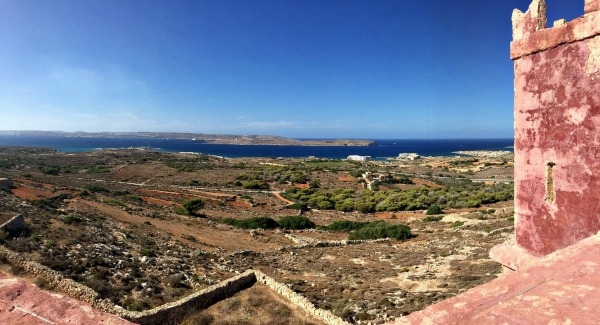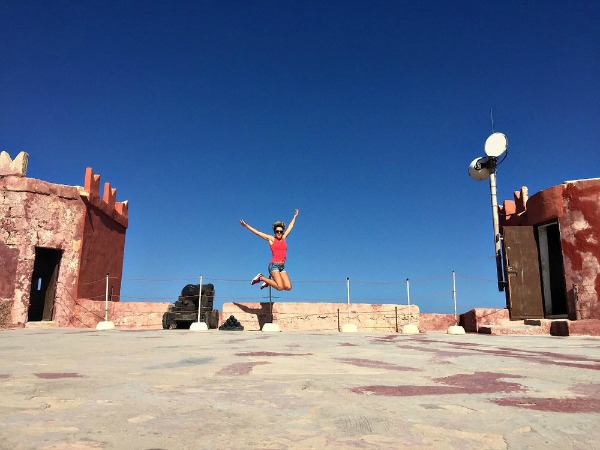The Red Tower in Mellieha
Some of you might be already familiar with this popular landmark. The bastioned watchtower is known under couple of names – Saint Agatha’s Tower (official name), the Red Tower, Mellieha Tower or Fort Saint Agatha.
Even though I generally try to visit hidden places and showcase forgotten or less popular sites, this time I decided to re-visit the Red Tower to remind ourselves, why this is a great place to visit (again & again) and share with you some interesting historical facts about this tower as every time I go, I learn something new.
This fortified watchtower is situated on the commanding heights of Marfa Ridge in Mellieha overlooking Ghadira Bay and the islands of Comino and Gozo. The only access to the tower is up a steep flight of steps, which used to be connected to the main entrance by a drawbridge.


Before the arrival of the Order of Saint John in 1530 and well into the first decades of the 17th century, the north-west part of Malta was very sparsely populated. This part of the island was easily reachable, yet totally unprotected from raids by the Ottoman Turks as well as opportunistic pirates.
St Agatha’s Tower was built over two years in 1648 – 1649 during the rule of the French Grand Master Jean Paul Lascaris de Castellar as part of a vast coastal defence system of fortifications and watch towers. It’s the sixth of the Lascaris towers and the last large bastioned tower to be built in Malta. It was designed by Antonio Garsin.
At the time of its construction it was the furthest outpost from the city of Valletta. The tower also served as a signaling post for communication between Malta and Gozo via St. Mary’s Tower on Comino.
Below you can see Din I-Art Helwa flag. Din I-Art Helwa is a non-governmental, non-profit and voluntary organisation, founded in 1965, that was granted the management of the Red Tower in 1998.


Once you walk through the entrance you will find yourself in the main hall. This is where the garrison used to live. They cooked, ate and slept here as well as kept their armour, weapons and gun-powder. The tower was usually manned by three to five members of the militia, but if there was a threat of incursion, the tower could be reinforced by up to fifty men!
Below the main hall is a water cistern, which stores rain water. It could hold up to 53,000 litres of water and supply fifty soldiers for about 40 days.


The second level and the roof was accessible from a stone spiral staircase, which was replaced by a wooden one during the reconstruction of the tower.
On the picture below you can see a view of the main hall from the second floor. This level was also used as additional sleeping quarters if needed. You can also notice the thickness of the outer walls, which are about 4 metres thick.


The Red Tower was completed in 1648 and fitter with cannons in 1649. Originally the tower was equipped with four guns, but in 1722 the fifth cannon was added to provide all around cover. The cannons that you can see today on the roof top are two 17th century cannon replicas.
The square roof is surrounded by four turrets, two of which are usually open to public. The turrets used to provide shelter to the guards from the wind and rain in winter and hot sun in summer. They were also used to store gun powder and weapons.


Aren’t these absolutely stunning views? I think they are just gorgeous. 360° view of the surrounding areas including Mellieha, Ghadira Bay, Comino, Gozo and Ghadira Natural Reserve.


Can you tell that I was really enjoying my visit? 🙂
Let’s not forget couple of organisational details. The entrance fee is only €2! Children under 12 go for free. The opening hours are from 15th September to 15th June: 10 am – 4 pm and from the 16th June to 14th September from 10 am – 5 pm. The Red Tower is closed on Christmas Day, New Year’s Day and Easter Sunday.
And if you were wondering, this whole time, why is it called Saint Agatha’s Tower, here is why…
Saint Agatha was a Christian martyr born in Catania, Sicily. She was tortured and put to death by her admirer, the Roman Prefect Quintianus whose advances she rejected. She suffered torture during which both of her breasts were cut off, but an apparition of St Peter cured her. However the torturing continued and she died in prison. It is said that the Red Tower is dedicated to Saint Agatha as her strength and faith would protect it and its keepers from earthquakes, fire, invasions and disease. It was common for the Knights to name fortifications after saints as they were a religious order as well as soldiers and hospitaliers.
Who would I recommend this place to visit? Culture & history enthusiasts, first time travellers, great views / scenery hunters. Not that great for people with physical disabilities because of the number of stairs.
I hope that you found this photo blog useful and you will give the Red Tower a visit in the near future. 🙂




Is this the same place where Mr. Dalli – the Chief Security Officer at Enemalta circa 1986 and an MLP election candidate – used to live?